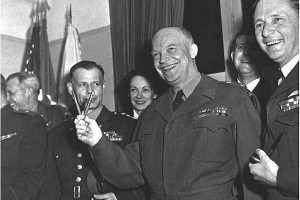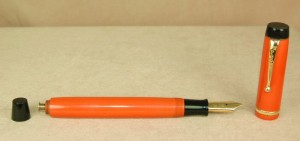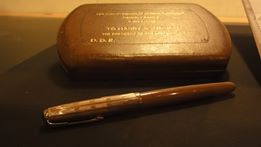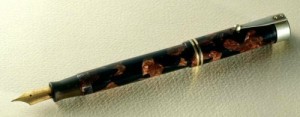Back in October of 2013 I discussed General MacArthur’s Big Red Parker Duofold and General Eisenhower’s Parker 51s used to sign the surrender treaties at the end of World War II because I had seen one of them in Paris’ Museum of the Army. The plot thickened when the museum responded with no knowledge of the Parker 51 I saw. They did mention a French General’s Parker Duofold used to sign treaties at the end of the war. Grandson of Kenneth Parker (who personally gave Ike a set of 51s to end the war), Geoff Parker then discussed his knowledge of the famed 51s.

Gen. Dwight Eisenhower holds up 2 of the pens used to sign the German surrender, ending World War II in Europe in May of 1945. One of those pens is a Parker 51, which is now on display in Paris’ Musee de l’Armee.
At the end of that article, I left a challenge for other pen collectors to find the Parker 51 I failed to photograph back in Paris.
Well, ladies and gentlemen, although nobody has sent us a photo, yet, the story caught the eye of fascinated WWII historians Cheryl H. and her husband Roy R. They had been reading John Toland’s “The Last 100 Days,” when they stumbled on these “Drippy Musings.” Bless their hearts, they tore into the mystery like a pit bull on a juicy marrow-filled bone.
Below is exactly what they found, and it is pretty fascinating for history and pen buffs! Unlike Geoff who said Ike had several pens to use, Toland limits it to two…the rest is Cheryl’s message to me:
Using numbers to make this a bit easier to follow….
1. Totally no doubt about the 2 gold pens: 1 gold plated and 1 solid gold from Kenneth Parker and that indeed Ike had carried around knowing they would eventually be used….
2. At Rheims, France, on May 6-7 in a local school Eisenhower waited in his office while the other participants assembled.
3. By the time everyone got done horsing around with what were eventually 3 surrender documents it was early on May 7, 1945. (Signing was at 2:41 a.m.)
4. The signers were: Ike’s Chief of Staff Walter Bedell Smith; Russian Major General Ivan Susloparov; French Major Francois Sevez; German General Alfred Jodl, and for the Brits, Major General Bernard Montgomery.
5. AHA! Ike didn’t sign!! (He refused to be in the same room with the Germans before they surrendered.)
6. BUT! Ike’s pens did! One of Ike’s aides named Butcher brought in the 2 Parker pens and gave the solid gold one to Walter Bedell Smith and the gold-plated one to Jodl. The solid gold one was passed to the other Allies by Walter Bedell Smith…that is, to Sevez, Susloparov, and Montgomery.
7. It appears as though Ike had planned to present one of the pens to President Truman and send the other to our old friend Kenneth Parker. That was his stated intent at one point, at least.
8. Aide Butcher, after Jodl signed with the gold plated Parker, took the Parker away from Jodl and gave Jodl his (Butcher’s) own personal Scheaffer pen to sign the following 2 documents as a nice little souvenir for Butcher. (Gotta love a guy who sees through the historic significance of the moment…..)
9. Previous to May, there had already been an armistice signed between Italy and the Allies. Mussolini and Alan Dulles for the U.S. (His brother was Ike’s Secretary of State John Foster Dulles) Sorry…appears no one knows or cares what pens were used!
10. At some date after May 7 there was another armistice signing on the eastern front between the Russians and the Germans…I think they used Bic ballpoints. [Cerf here: Ballpoints came into prominence during the war, but Bic didn’t make the first ones. So likely not Bic. Bic was founded Oct. 25, 1945.]
But this leaves the question of Generale Tassigny…his pen is photographed and he must have signed something with it…but it does not appear to be the documents at Rheims. Guess someone will have to go to Paris to figure out that little puzzle. (I will probably burn up the internet tomorrow or sometime to work on that…)
(AND search she did. She continues…)
Re: French Major Generale Tassigny. I think we have solved that one. On May 7 I believe that M.G. Tassigny was a “witness” to Major Sevez’s signing. The next day, May 8, there were another series of surrender papers signed (by now the Russians had arrived at Rheims) and M.G. Tassigny did actually sign that day. What I/we didn’t realize is that there were a number of different surrender documents, signed over a number of days, and signed by various people. The French are so (justifiably) proud of their history and their people that it seems to me that since they have M.G. Tassigny’s pen, why not use it as fully as possible? He did indeed sign an armistice/surrender document. BTW…one reason for various surrenders was that the Russians didn’t trust anyone, and few trusted the Russians!
Another little tidbit: Ike told, I think it was, Walter Bedell Smith, that of the 2 Parker pens, one would go to President Truman and one to Kenneth Parker. Bedell Smith replied,” What about Churchill?” to which Ike said, “Oh darn it. (or something like that!) I forgot about him!” That leaves me puzzled because Ike had to have given Churchill “something;” the pen in Ike’s Abilene library is no doubt the one used on May 7 by Bedell Smith.
Me again. Just to clarify, the pen at the Eisenhower Presidential Library is the pen he gave to Truman. Geoff Parker thinks it is possible there were more than two pens, so that Churchill and Kenneth each could have gotten a token of the surrender. And that, dear friends, is what we have found so far.Always feel free to contribute, as we love to hear from other dedicated pen fans and historians!


 Shopping Cart
Shopping Cart







